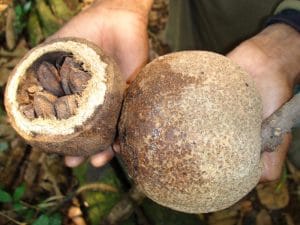Brazil Nuts are really Seeds – getting to know your food
Brazil nuts are technically  seeds, not nuts, and develop inside a softball-sized fruit capsule, (which strongly resembles a coconut), containing 10 to 25 three-sided “nuts” inside with extremely hard shells. A mature tree can produce more than 250 pounds of nuts a year.
seeds, not nuts, and develop inside a softball-sized fruit capsule, (which strongly resembles a coconut), containing 10 to 25 three-sided “nuts” inside with extremely hard shells. A mature tree can produce more than 250 pounds of nuts a year.
Next time you are wandering through the rainforest you might want to keep an eye out for what look and sound like 5 lb. cannonballs, crashing down from above at more than 50 miles an hour.
The Brazil nut tree, known scientifically as Bertholletia excelsa, is native to the Guianas, Venezuela, Brazil, eastern Colombia, eastern Peru, and eastern Bolivia.
Towering at 30 to 45 metres (100 to 200 ft) tall and 1 to 2 metres (3 to 6.5 ft) trunk diameter, they are among the largest of trees in the Amazon Rainforests and may live for 500 years or more, and according to some authorities often reaches an age of 1,000 years.
But what kind of animal is able to break open the rock-hard fruits, so they can sprout into new trees? and why do only trees in undisturbed forests bear fruit?
The Agouti — a small mammal that looks a bit like a large guinea pig and have small, chisel-like teeth, can penetrate the Brazil nut’s seed case. They eat some and carry away and bury others. Seeds can stay dormant in the soil for years, waiting for the perfect conditions to germinate and grow into a new Brazil nut tree. (sounds like our squirrels….)
The trees are excellent illustrations of the complex web of interdependence which characterizes delicate eco-systems.
When they bloom, the trees produce complex, coiled, yellow flowers, containing very sweet nectar which cannot be penetrated by most pollinators. One species of bee, (Euglossa spp), can “unlock” flowers, but it is only found in the pres ence of a particular orchid. It takes about 14 months for the fruit to mature after pollination.
ence of a particular orchid. It takes about 14 months for the fruit to mature after pollination.
For the bees to survive, the males must attract mates, and to do that, the male bees need a fragrance from a particular orchid (Coryanthes vasquezii), to attract female bees. If the forest is damaged and the orchids disappear, so will the bees — and the Brazil nuts -again reminding us of the delicate balance of the world we are part of.
Therefore, Brazil nuts will only be produced in rain forest regions which have this orchid. In turn, the tree relies on animals like the agouti to seed itself.
Competition also comes from a sneaky plant known as the strangler fig tree, which start out as tiny, almost invisible seeds deposited on a branch by small mammals or birds. The seed sprouts, and a tiny root gains a foothold. It’s the beginning of the end.
Eventually, the root creeps down the trunk to the forest floor, stealing water and nutrients from the tree through its bark as it goes. More roots soon join in, wrapping tight around the Brazil nut tree, encasing its victim. Ultimately, over decades, the tree dies, leaving the fig standing like a hollow monument to this epic struggle.
In the sparsely populated Amazon, where barter is common and opportunities to earn cash are few, Brazil nuts are a vital industry. In the Brazilian Amazon alone, harvesters annually collect about 45,000 tons valued at about $43 million worldwide.
Watch for my next blog all about the pros and cons of the fascinating nutrition facts of brazil nuts!

Leave a Reply